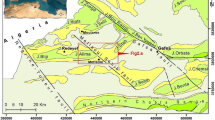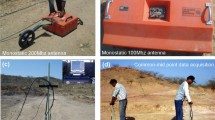Abstract
In the Grande da Pipa river basin, north of Lisbon, 64 % of the total number of landslides inventoried is totally or partially included in a lithological unit composed by marl, clay, and sandstone intercalation complex that is present in 58 % of the study area. The Persistent Scatterer synthetic aperture radar interferometry technique is applied to a data set of TerraSAR-X SAR images, from April of 2010 to March of 2011, firstly to the Laje-Salema test site and further exported to the Grande da Pipa river basin. This work’s specific objectives are the following: (i) to assess the potential of the Persistent Scatterer displacement maps to the identification of new landslides/unstable areas and in the redefinition of landslide limits, (ii) to update the landslide state of activity, and (iii) to evaluate the capacity of the Persistent Scatterer deformation maps in assessing landslide susceptibility at the regional scale. Based on this approach, it was possible to increment the number of landslides and to redefine the landslide limits in the test site in 3.8 %. For 39 landslides, it was possible to update the landslide state of activity, in particular from dormant to reactivated or dormant-reactivated (23 landslides) or from stabilized to reactivated (5 landslides). Landslide susceptibility map based in Persistent Scatterer deformation rates, independently validated with a deep rotational slide map, obtained the best value of area under the curve (0.668).










Similar content being viewed by others
References
Allievi J, Ambrosi C, Ceriani M, Colesanti C, Crosta GB, Ferretti A, Fossati D (2003) Monitoring slow mass movements with the Permanent Scatterers technique. Geosci. Remote Sens. Symposium, IGARSS ‘03 Proceedings. 2003 I.E. International 1:215–217.
Alonso EE, Pineda JA, Cardoso R (2010) Degradation of marls; two case studies from the Iberian Peninsula. In: Calcaterra D, Parise M (eds) Weathering as a predisposing factor to slope movements, Geological Society, London, Eng. Geol.Special Publications 23, pp 47–75.
Arturi A, Del Frate F, Lategano E, Schiavon G, Stramondo S (2004) The 1998 Sarno (Italy) landslide from SAR interferometry. Proceedings of FRINGE 2003 Workshop. ESA SP‐550, Italy
Berardino P, Costantini M, Franceschetti G, Iodice A, Pietranera L, Rizzo V (2003) Use of differential SAR interferometry in monitoring and modelling large slope instability at Maratea (Basilicata, Italy). Eng Geol 68:31–51
Bianchini S, Cigna F, Righini G, Proietti C, Casagli N (2012) Landslide HotSpot mapping by means of Persistent Scatterer Interferometry. Environ Earth Sci 67(4):1155–1172
Blanco‐Sánchez P, Mallorqui JJ, Duque S, Monells D (2008) The Coherent Pixels Technique (CPT): An Advanced DInSAR Technique for Nonlinear Deformation Monitoring. Pure Appl Geophys 165:1167–1193
Casagli N, Colombo D, Ferretti A, Guerri L, Righini G (2008) Case study on local landslide risk management during crisis by means of remote sensing data. Proceedings First Landslide Forum, University of United Nations, Tokyo. Parallel session volume, p 125-128.
Catalão J, Nico G, Hanssen R, Catita C (2011a) Merging GPS and atmospherically corrected InSAR data to map 3D terrain displacement velocity. IEEE Trans Geosci Remote Sens 49(6):2. doi:10.1109/TGRS.2010.2091963
Catalão J, Nico G, Conde V (2011b) Detection of ground subsidence in the city of Lisbon: comparison of InSAR and topographic measurements. In Stilla U, Gamba P, Juergens C, Maktav D (eds) JURSE 2011—Joint Urban Remote Sensing Event, Munich, April 11–13, p 417–420.
Cigna F, Del Ventisette C, Liguori V, Casagli N (2011) Advanced radar‐interpretation of InSAR time series for mapping and characterization of geological processes. Nat Hazards Earth Syst Sci 11:865–881
Cigna F, Bianchini S, Casagli N (2012) How to assess landslide activity and intensity with Persistent Scatterer Interferometry (PSI): the PSI-based matrix approach. Landslides. doi:10.1007/s10346-012-0335-7
Colesanti C, Wasowski J (2006) Investigating landslides with space‐borne Synthetic Aperture Radar (SAR) interferometry. Eng Geol 88:173–199
Colesanti C, Ferretti A, Prati C, Rocca F (2003) Monitoring landslides and tectonic motions with the Permanent Scatterers Technique. Eng Geol 68:3–14
Colesanti C, Crosta GB, Ferretti A, Ambrosi C (2006) Monitoring and assessing the state of activity of slope instabilities by the permanent scatterers technique. In: Evans SG, Mugnozza GS, Strom A, Hermanns RL (eds) Landslides from massive rock slope failure. NATO Science Series, IV Earth and Environmental Sciences, vol 49. Springer, Netherlands, pp 175–194
Cruden DM, Varnes DJ (1996) Landslide types and processes. In Turner AK, Schuster RL (eds), Landslides investigation and mitigation. Transportation Research Board. National Academic Press, Washington DC Special Report 247:36–75.
Eineder M, Runge H, Boerner E, Bamler R, Adam N, Schättler B, Breit H, Suchandt H (2003) SAR Interferometry with TerraSAR-X. Proc. of FRINGE 2003 Workshop, Frascati, 1–5 December 2003 (ESA SP-550, June 2004)
Farina P, Moretti S, Colombo D, Fumagalli A, Manunta P (2004) Landslide risk analysis by means of remote sensing techniques: results from the ESA/SLAM project. Geosci Remote Sens. Symposium, 2004. IGARSS ‘04. Proceedings. 2004 I.E. International.
Farina P, Colombo D, Fumagalli A, Marks F, Moretti S (2006) Permanent Scatterers for landslide investigations: outcomes from the ESA‐SLAM project. Eng Geol 88:200–217
Fell R, Ho KKS, Lacasse S, Leroi E (2005) A framework for landslide risk assessment and management. Proceedings International Conference on Landslide Risk Management. Taylor & Francis, London, pp 3–25
Ferretti A, Prati C, Roca F (2001) Permanent Scatterers in SAR interferometry. IEEE Trans Geosci Remote Sens 39(1):8–20
Ferretti A, Monti-Guarnieri A, Prati C, Rocca F, Massonnet D (2007) InSAR Principles: Guidelines for SAR Interferometry Processing and Interpretation. In: Fletcher K (ed) ESA Publications TM-19, ESTEC
Frattini P, Crosta GB, Allievi J (2013) Damage to buildings in large slope rock instabilities monitored with the PSInSARTM technique. Remote Sens 5:4753–4773
Guzzetti F, Manunta M, Ardizzone F, Pepe A, Cardinali M, Zeni G, Reichenbach P, Lanari R (2009) Analysis of ground deformation detected using the SBAS‐DInSAR technique in Umbria, Central Italy. Pure Appl Geophys 166:1425–1459
Herrera G, Davalillo JC, Mulas J, Cooksley G, Monserrat O, Pancioli V (2009) Mapping and monitoring geomorphological processes in mountainous areas using PSI data: Central Pyrenees case study. Nat Hazards Earth Syst Sci 9:1587–1598
Hilley GE, Bürgmann R, Ferretti A, Novali F, Rocca F (2004) Dynamics of slow‐moving landslides from Permanent Scatterer Analysis. Science 304:1952–1955
Hooper A, Zebker H, Segall P, Kampes B (2004) A new method for measuring deformation on volcanoes and other natural terrains using InSAR persistent scatterers. Geophys Res Lett 31, L23611. doi:10.1029/2004GL021737
Hooper A, Segall P, Zebker H (2007) Persistent scatterer interferometric synthetic aperture radar for crustal deformation analysis, with application to Volcano Alcedo, Galapagos. J Geophys Res B Solid Earth 112(B7):B07407
IUGS/WGL International Union of Geological Sciences Working Group on Landslides (1995) A suggested method for describing the rate of movement of a landslide. Bull Int Assoc Eng Geol 52:75–78
Kampes B, Hanssen R, Perski Z (2003) Radar interferometry with public domain tools. Proceedings of FRINGE 2003, Frascati, p 1–5.
Kullberg JC, Rocha RB, Soares AF, Rey J, Terrinha P, Callapez P, Martins L (2006) A Bacia Lusitaniana: Estratigrafia, Paleogeografia e Tectónica. In: Dias R, Araújo A, Terrinha P, Kullberg JC (eds) Geologia de Portugal no contexto da Ibéria. Universidade de Évora, p 317–368
Lu P, Casagli N, Catani F, Tofani V (2012) Persistent Scatterers Interferometry Hotspot and Cluster Analysis (PSI-HCA) for detection of extremely slow-moving landslides. Int J Remote Sens 33(2):466–489
Lu P, Catani F, Tofani V, Casagli N (2013) Quantitative hazard and risk assessment for slow-moving landslides from Persistent Scatterer Interferometry. Landslides 11(4):685–696
Metternicht G, Hurni L, Radu G (2005) Remote sensing of landslides: an analysis of the potential contribution to geo‐spatial systems for hazard assessment in mountainous environments. Remote Sens Environ 98:284–303
Nico G, Oliveira S, Catalão J, Zêzere JL, Garcia RAC (2010) Landslide susceptibility mapping based on Persistent Scatterers inventories. In Lacoste‐Francis H (ed) ESA Communications, ESTEC, Noordwijk, The Netherlands. Proceedings of the “ESA Living Planet Symposium”, Bergen, Norway, European Space Agency. SP‐686, December 2010, ISBN ‐ 978‐92‐9221‐241‐4, ©2010 European Space Agency.
Oliveira SMC (2012) Incidência Espacial e Temporal da Instabilidade Geomorfológica na Bacia do Rio Grande da Pipa (Arruda dos Vinhos). PhD Dissertation, University of Lisbon (in Portuguese).
Oliveira SC, Zêzere JL, Garcia RAC (2014) Structure and characteristics of landslide input data and consequences on landslide susceptibility assessment and prediction capability. In: Lollino G et al (eds) Engineering geology for society and territory, vol 2. Springer International Publishing, Switzerland. doi:10.1007/978-3-319-09057-3_24
Piedade AMM, Zêzere JL, Garcia RAC, Oliveira SC (2011) Modelos de susceptibilidade a deslizamentos superficiais translacionais na região a norte de Lisboa. Finisterra 46(91):9–26
Pimenta RSGG (2011) Avaliação da susceptibilidade à ocorrência de movimentos de vertente com métodos de base física. MSc Dissertation, Faculty of Sciences, University of Lisbon (in Portuguese).
Prati C, Rocca F, Ferretti A (2004) Radar Interferometry using spaceborne data: potentials and operational capabilities. In: JRC (ed) Workshop on risk mitigation of slope instability. JRC Institute for the Protection and Security of the Citizen, Ispra
Riedel B, Walther A (2008) InSAR processing for the recognition of landslides. Adv Geosci 14:189–194
Righini G, Pancioli V, Casagli N (2012) Updating landslide inventory maps using Persistent Scatterer Interferometry (PSI). Int J Remote Sens 33(7):2068–2096
Rott H, Nagle T (2006) The contribution of radar interferometry to the assessment of landslide hazards. Adv Space Res 36:710–719
Schiavon G, Del Frate F, D’Ottavio D, Stramondo S (2003) Landslide identification by SAR interferometry: the Sarno case. Int Geosci Remote Sens Symp (IGARSS) 4:2428–2429
Squarzoni C, Delacourt C, Allemand P (2003) Nine years of spatial and temporal evolution of the La Valette landslide observed by SAR interferometry. Eng Geol 68:53–66
Tofani V, Segoni S, Agostini A, Catani F, Casagli N (2013) Technical note: use of remote sensing for landslide studies in Europe. Nat Hazards Earth Syst Sci 13(1):299–309
Tsutsui K, Rokugawa S, Nakagawa H, Miyazaki S (2007) Detection and volume estimation of large scale landslides based on elevation‐change analysis using DEMs extracted from high‐resolution satellite stereo imagery. IEEE Trans Geosci Remote Sens 45(6):1681–1695
Wasowski J, Bovenga F (2014) Investigating landslides and unstable slopes with satellite Multi Temporal Interferometry: current issues and future perspectives. Eng Geol 174:103–138
WP/WLI International Geotechnical Societies - Working Party on World Landslide Inventory, UNESCO (1993) A suggested method for describing the activity of a landslide. Bull Int Assoc Eng Geol 47:53–57
Yan TZ (1988) Recent advances of quantitative prognoses of landslides in China. In: Bonnard C (ed) Landslides, Proceedings of the 5th ISL, Lausanne, vol 2. Balkema, Rotterdam, pp 1263–1268
Yin KL, Yan TZ (1988) Statistical prediction models for slope instability of metamorphosed rocks. In: Bonnard C (ed) Landslides, Proceedings of the 5th ISL, Lausanne, vol 2. Balkema, Rotterdam, pp 1269–1272
Zbyszewski G, Assunção CT (1965) Notícia explicativa da folha 30‐D (Alenquer). Carta Geológica de Portugal (1:50 000). Serviços Geológicos de Portugal, Lisboa
Zêzere JL, Trigo RM, Trigo IF (2005) Shallow and deep landslides induced by rainfall in the Lisbon region (Portugal): assessment of relationships with the North Atlantic Oscillation. Nat Hazards Earth Syst Sci 5:331–344
Acknowledgments
This work is within the framework of the Project Pan-European and nation-wide landslide susceptibility assessment, European and Mediterranean Major Hazards Agreement (EUR-OPA). The first author was funded by a postdoctoral grant (SFRH/BPD/85827/2012) from the Portuguese Foundation for Science and Technology (FCT)
Author information
Authors and Affiliations
Corresponding author
Rights and permissions
About this article
Cite this article
Oliveira, S.C., Zêzere, J.L., Catalão, J. et al. The contribution of PSInSAR interferometry to landslide hazard in weak rock-dominated areas. Landslides 12, 703–719 (2015). https://doi.org/10.1007/s10346-014-0522-9
Received:
Accepted:
Published:
Issue Date:
DOI: https://doi.org/10.1007/s10346-014-0522-9




